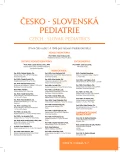Syphilis congenita recens – case report
Authors:
L. Krbková 1; L. Klapačová 1; J. Bednářová 2; P. Pospíšilová 3; B. Pinková 4; H. Zákoucká 5
Authors‘ workplace:
Klinika dětských infekčních nemocí LF MU a FN Brno
1; Oddělení klinické mikrobiologie, FN Brno
2; Laboratoř bakteriální genetiky a genomiky, Biologický ústav LF MU, Brno
3; Dětské kožní oddělení, Pediatrická klinika LF MU a FN Brno
4; Národní referenční laboratoř pro diagnostiku syfilis, Státní zdravotní ústav, Praha
5
Published in:
Čes-slov Pediat 2017; 72 (7): 404-408.
Category:
Kazuistika byla prezentována jako klinická desetiminutová přednáška na XXI. slovensko-českém kongresu o infekčních chorobách v Bratislavě, 16. 6. 2017
Overview
Treponema pallidum infection can occur during any stage of pregnancy in the case of untreated or insufficiently treated maternal syphilis. Nevertheless, the transmission to the foetus is most probable during spirochetaemia in the early stage of pregnancy.
We present the case of congenital syphilis diagnosed in the third month of age. The screening for hepatitis B and syphilis were negative in the first trimester of pregnancy. The mother was diagnosed with urogenital infection in the sixth month of pregnancy, she was treated with acyclovir as herpes genitalis, but likely primary syphilitic lesions would have been the correct diagnosis. She delivered spontaneously a 2,810 g – female in the 40th week of pregnancy. The screening for treponemal antibodies was not done.
The infection started with coryza syphilitica in the third month of age followed by skin lesions around the mouth and on the thighs. On admission, the infant’s skin changes were significant for congenital syphilis. Anemia, increased liver enzymes and positive non-treponemal and treponemal tests dominated in laboratory findings. RPR was 1:64, ELISA IgM and IgG were repeatedly positive, confirmed by Western blot (antibodies to Tp47, Tp17, Tp15). In clinical samples (from buccal mucosa and from skin lesion) T. pallidum DNA was detected by PCR. The test was positive for one locus from 3 typing genes (TP0548). Either CSF abnormalities or intrathecal synthesis were proven. The infant was treated with ceftriaxone intravenously for 14 days.
Keywords:
Treponema pallidum, congenital syphilis, syphilitic skin lesions, screening during pregnancy/at birth
Sources
1. Lago EG, Vacari A, Fiori RM. Clinical features and follow-up of congenital syphilis. Sex Transm Dis 2013; 40 (2): 85–94.
2. Woznicová V, Šmajs D, Wechsler D, et al. Detection of Treponema pallidum subsp. pallidum from skin lesions, serum, and cerebrospinal fluid in an infant with congenital syphilis after clindamycin treatment of the mother during pregnancy. J Clin Microbiol 2007; 45 (2): 659–661.
3. Lee M, Robinson JL, Lee BE, et al. An infant with seizures, rash, and hepatomegaly. Clin Infect Dis 2008; 46 (1): 451–452, 472–473.
4. Michelov IC, Wendel GD, Norgard MV, et al. Central nervous system infection in congenital syphilis. N Engl J Med 2002; 346: 1792–1798.
5. Fojaco RM, Hensley GT, Moskowitz L. Congenital syphilis and necrotizing funisitis. JAMA 1989; 261: 1788–1790.
6. Herremans T, Kortbeek L, Notermans DW. A review of diagnostic tests for congenital syphilis in newborns. Eur J Clin Microbiol Infect Dis 2010; 29: 495–501.
7. Grillová L, Pětrošová H, Mikalová L, et al. Molecular typing of Treponema pallidum in the Czech Republic during 2011 to 2013: increased prevalence of identified genotypes and of isolates with macrolide resistance. J Clin Microbiol 2014; 52 (10): 3693–3700.
8. Janier M, Hegyi V, Dupin N, et al. 2014 European guideline on the management of syphilis. J Eur Acad Dermatol Venereol 2014; 28 (12): 1581–1593.
9. Lukehart SA, Hook EW 3rd, Baker-Zander SA, et al. Invasion of the central nervous system by Treponema pallidum: implications for diagnosis and treatment. Ann Intern Med 1988; 109: 855e62.
10. Lewis DA, Lukehart SA. Antimicrobial resistance in Neisseria gonorrhoeae and Treponema pallidum: evolution, therapeutic challenges and the need to strengthen global surveillance. Sex Transm Infect 2011; 87:ii39eii43.doi:10.1136/sti.2010.047712.
11. Pacifici GM. Pharmacokinetics of cephalosporins in the neonate: a review. Clinics 2011; 66 (7): 1267–1274.
12. Vyhláška MZ ČR č. 306/2012 Sb., o podmínkách předcházení vzniku a šíření infekčních onemocnění a o hygienických požadavcích na provoz zdravotnických zařízení a ústavů sociální péče. Praha: MZ ČR 2012.
13. European Centre for Disease Prevention and Control. Antenatal screening for HIV, hepatitis B, syphilis and rubella susceptibility in the EU/EEA – addressing the vulnerable populations. Stockholm: ECDC; 2017 http://ecdc.europa.eu/en/publications/. doi: 10.2900/50174.
14. Zákoucká H, Křemenová S, Křemen J. Problematika vrozené syfilis v posledních dvaceti letech. I. Etiologie, epidemiologie a diagnostika. Klin Mikrobiol Inf Lék 2006; 12 (2): 44–50.
15. Centers for Disease Control and Prevention: Sexually transmitted diseases (STDs), 2015. www.cdc.gov/std/tg2015/congenital.htm.
16. De Santis M, De Luca C, Mappa I, et al. Syphilis infection during pregnancy: fetal risks and clinical management. Infect Dis Obstret Gynecol 2012; doi:10.1155/2012/430558.
17. Hawkes S, Matin N, Broutet N, et al. Effectiveness of interventions to improve screening for syphilis in pregnancy: a systematic review and meta-analysis. Lancet Inf Dis 2011; 11 (9): 684–691.
Labels
Neonatology Paediatrics General practitioner for children and adolescentsArticle was published in
Czech-Slovak Pediatrics

2017 Issue 7
Most read in this issue
- A rare case of congenital thyroglossal cyst with cysto-tracheal fistula: case report
- Survey of adverse childhood experiences in the Czech Republic
- Syphilis congenita recens – case report
- Rotaviruses and other agents causing gastroenteritis in patients hospitalized at the Department of Pediatric Infectious Diseases, University Hospital, Brno, in 2015–2016
